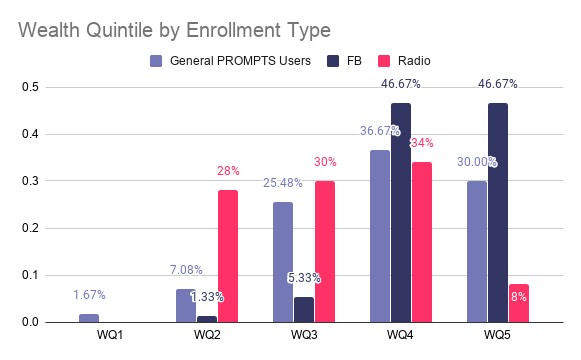Is our solution reaching those who need it the most?
The goal of PROMPTS, Jacaranda’s digital health platform for pregnant women and new mothers, is to reach underserved mothers who need better information and access to care during pregnancy. We initially launched and scaled the program using SMS because mobile phone penetration is high in Kenya, and although many people have access to phones that support data (and therefore messaging tools like WhatsApp), our early research found that internet ‘access’ does not always equate to usage, particularly for a new mother who is cash-strapped and cannot afford to pay for data.
SMS is ubiquitous, and our new findings reiterate that this is the best channel to reach most women. But as PROMPTS expands across Kenya, we are particularly interested in seeing how we can reach all economic segments of society with our platform, including those in lower wealth quintiles.
Is PROMPTS reaching underserved populations?
From the perspective of pregnant women and new mothers, PROMPTS is a free, simple, two-way text messaging (SMS) information service [2]. The majority of PROMPTS users are enrolled when they visit a public hospital for antenatal care, but as we expanded, we recently tested new methods for enrolling women onto PROMPTS using Facebook ads and local radio campaigns to see if these channels might help reach more women faster. We conduct quarterly phone surveys of PROMPTS users to understand user demographics and care-seeking behaviours.
We used these surveys to understand whether we were reaching demographically distinct populations with these enrolment approaches. We used an equity analysis from EquityTool, which identifies ‘Wealth Quintiles’, or economic categories, that our users fall into (see explanation of methods below) [3].

What we learnt
The majority (90+%) of our normative PROMPTS users seek care at public hospitals, and 70% of these users fall into WQ 2-4 (‘General PROMPTS users’ in Fig 1). This is in line with our assumptions that enrollment in an SMS program reaches the bulk of Kenyan mothers who are seeking care in public hospitals. A few findings from of the analysis of radio and Facebook enrollment suggest interesting opportunities to reach a broader and more representative population:
- 28% of those who enrolled by radio were in the poorer WQ 2, whereas only 1% of the Facebook enrollees fell in that quintile.
- 47% of those who enrolled via Facebook were in the wealthiest quintile (WQ 5), compared with only 8% of those who enrolled from radio. This may highlight the limitations of data platforms such as FB and WhatsApp to reach the lower wealth quintiles.
- Those who enrolled via Facebook generally had smartphones (95%), while those who enrolled via radio mostly had feature phones (78%)
- The majority of women who enrolled via both Facebook and radio utilized public facilities for antenatal care and delivery (65% of Facebook enrollees and 90% of radio enrollees), but those who enrolled via Facebook had higher rates of using private facilities (26%) compared to those who enrolled via radio (only 8%).
What does this mean for our programs?
Our analysis seems to indicate the value of a ‘portfolio approach’ to PROMPTS enrollment. We learned that radio may be a more effective channel for PROMPTS to reach poorer women when compared with our traditional enrollment methods in clinics. Enrollment by radio is more costly than using social media, but we have been working with counties to use public health hours and recognize the importance of reaching women in this economic category. Facebook, on the other hand, appears to be an affordable and efficient channel for reaching women in urban areas like Nairobi – who also benefit significantly from PROMPTS services – but may not be effective in poorer, rural counties.
The wealth analysis highlights an area for continued work: unsurprisingly, we do not see the lowest income quintile (WQ 1) being reached by PROMPTS. This most likely reflects some combination of factors: that the very poorest women do not always seek care in government health facilities; that not all the very poorest women have reliable access to phones; and that the counties where we have worked to date have a lower proportion of women in this quintile. Many of these women live in the most rural areas, where access to healthcare in general is lower.
We currently partner with counties in the urban and peri-urban corridor in Kenya stretching from Mombasa to Kisumu, which tends to be ‘wealthier’ than other regions. We also recognise that women who fall into WQ 1 may require different innovations in outreach because of differences in literacy, phone ownership, etc. We will be exploring new channels as we expand further into regions with a higher proportion of WQ 1 women and will continue to share our findings.
Our mission is to ensure all women have access to safe, respectful maternity care, and so we are hyper-focused on reaching the under-served. These results reinforced our decision to maintain SMS as the primary means of communicating with our users, rather than web-based platforms like WhatsApp or Facebook. Digital connectivity is exciting and may be ubiquitous some day, but we hope these results will help other organisations recognise and advocate for more expensive (and less glamorous) approaches that are still required to reach the underserved.
_
References:
[1] GSMA Country Report: Kenya https://www.mobileconnectivityindex.com/#year=2019&zoneIsocode=KEN&analysisView=KEN
[2] Jones, Rachel M., et al. “A Short Message Service (SMS) increases postpartum care-seeking behavior and uptake of family planning of mothers in peri-urban public facilities in Kenya.” PloS one 15.9 (2020): e0239213. Viewable Online: https://journals.plos.org/plosone/article?id=10.1371/journal.pone.0239213
[3] EquityTool is managed by Metrics for Management. Experts in the field of wealth measurement and the Demographic and Health Survey (DHS) wealth index developed a validated method to simplify equity assessment. More information can be found at www.equitytool.org


